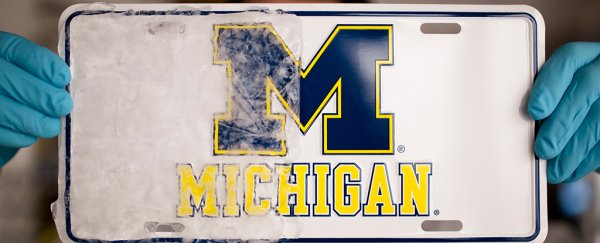Ice on your windshield is a nuisance, and on an aeroplane, it can be deadly. So researchers have come up with a new kind of ice-repellent coating that's both durable and cheap, and could do a better job at keeping our vehicles and machines free from ice for longer.
The new 'icephobic' coating can be sprayed on to surfaces, and once applied, it causes the ice to simply slide off. It's thin, clear, and slightly rubbery to the touch, and it's been put together using a blend of common synthetic rubbers. It improves on existing ice-protection formulae that rely on making surfaces either very water-repellent or very slippery, says the team from the University of Michigan.
"Researchers had been trying for years to dial down ice adhesion strength with chemistry, making more and more water-repellent surfaces," explained one of the team, Kevin Golovin. "We've discovered a new knob to turn, using physics to change the mechanics of how ice breaks free from a surface."
Golovin and his colleagues discovered that repelling water wasn't as important as previously thought in concocting an ice-repellent. Instead, a phenomenon called interfacial cavitation could be used to stop the ice from sticking.
Whereas two rigid surfaces can become very tightly stuck together (like ice and your car windshield), a rigid surface and a rubbery surface (like the new coating) can come apart very easily, because even a small amount of pressure deforms the rubbery side.

"Nobody had explored the idea that rubberiness can reduce ice adhesion," said lead researcher, Anish Tuteja. "Ice is frozen water, so people assumed that ice-repelling surfaces had to also repel water. That was very limiting."
What makes the innovation particularly exciting is that it can be fine-tuned as required - the scientists are able to balance the level of ice-repellence and durability. On an aeroplane, for example, the durability takes priority, and winds and vibrations will help to push the ice of in any case. Inside a freezer, on the other hand, the level of ice-repellence could be dialled up, because the coating wouldn't need to be as durable.
The special coating can be made smooth or rough to the touch, and with varying degrees of water-repellence. This flexibility means it can potentially be used in all kinds of scenarios. In the picture above, you can see a licence plate that's been pulled from a freezer, with the icephobic coating used on the right-hand side.
The researchers say their discovery could have major benefits in industries such as energy, shipping, and transportation, where cold climates can be a problem, and it could also help make freezers frost-free without requiring any extra power.
The results have been published in the journal Science Advances.
